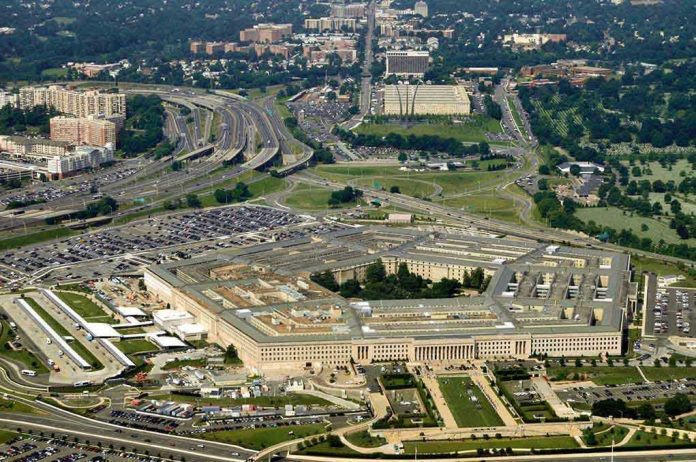🔴 Website 👉 https://u-s-news.com/
Telegram 👉 https://t.me/usnewscom_channel
In a move raising serious questions about the stability of America’s armed forces, the sudden early retirement of Air Force Chief Gen. David W. Allvin leaves the door open for more political shakeups at the highest levels of military leadership.
Story Snapshot
- Gen. Allvin retires two years into a four-year term, with no official reason offered for his early departure.
- His exit follows a wave of senior military turnover since the start of Trump’s second term, sparking concerns about consistent leadership.
- Ongoing Air Force modernization and force structure reforms now face uncertainty as a new chief is selected.
- The Trump administration’s rapid transformation and cost-cutting have influenced top military roles and priorities.
Unexpected Early Retirement Disrupts Air Force Leadership
On August 18, 2025, the Pentagon confirmed that Gen. David W. Allvin, the 23rd Chief of Staff of the U.S. Air Force, will retire in early November—just halfway through his expected four-year tenure. The abrupt nature of Allvin’s departure is highly unusual. Traditionally, Air Force chiefs serve a full term, providing stability and continuity at the top of the service. No official explanation has been provided for his early exit, fueling speculation about the underlying causes and potential disruptions to the Air Force’s ongoing strategic initiatives.
Gen. Allvin’s time as chief coincided with significant modernization efforts, including contracts for next-generation fighter jets and investments in collaborative combat aircraft. Under President Trump’s administration, the Air Force has undergone workforce reductions and shifting priorities, reflecting a broader push for rapid transformation and fiscal discipline. These policies, while aiming to restore American military might and curb wasteful spending, have also contributed to an atmosphere of uncertainty among top brass. Previous early departures from this post were typically linked to promotions or scandals, making Allvin’s unexplained exit stand out as an anomaly.
Broader Pattern of Senior Military Turnover Raises Concerns
Allvin’s early retirement is not an isolated incident. Recent years have seen a pattern of senior military leaders leaving their posts ahead of schedule, a trend that has accelerated since the Trump administration resumed in 2025. Gen. CQ Brown left the Air Force chief’s role early for a high-profile promotion, while Gen. Michael Moseley resigned in 2008 amid controversy. This latest shakeup comes amid a backdrop of ongoing Air Force transformation, including force structure changes and deployment model reforms—some of which have faced delays or pauses in recent months. The White House’s direct influence over military appointments and priorities is more pronounced, with the President, Secretary of the Air Force, and Secretary of Defense all playing decisive roles in leadership transitions.
Pentagon Confirms Air Force Chief Allvin Will Step Down Early | https://t.co/igEaydfuNT https://t.co/zkkO4l38Cl
— ConservativeLibrarian (@ConserLibrarian) August 19, 2025
Leadership changes at the top inevitably cause ripples throughout the ranks. Airmen, defense contractors, and civilian leaders now face the challenge of maintaining momentum in key programs while adapting to new leadership priorities. Some of the Air Force’s most ambitious modernization projects may be delayed or reprioritized, depending on who is selected as the next chief and what vision they bring to the table. For defense industry partners, uncertainty about contracts and procurement strategies could have broader economic implications, particularly as the administration seeks to balance modernization with cost control.
Implications for Military Stability and National Security
Analysts and experts agree that frequent turnover among senior military leaders can undermine organizational cohesion and effectiveness. The absence of an official explanation for Gen. Allvin’s departure has sparked debate about possible internal disagreements or political pressures. While some observers view the retirement as a personal decision, others believe it reflects deeper tensions within the military’s relationship to civilian leadership. The Trump administration’s hands-on approach to defense policy—combined with aggressive timelines for reform—has placed extraordinary demands on military leaders tasked with executing complex, multi-year strategies.
In the short term, the Air Force is working to ensure a smooth transition, with Allvin remaining in place until a Senate-confirmed successor is named. Yet the long-term effects remain uncertain. The next chief’s priorities will shape not only the Air Force’s modernization trajectory but also set expectations for the tenure and independence of future military leaders. As the nation navigates a period of heightened global competition and domestic scrutiny of defense spending, the stability and effectiveness of senior command are more critical than ever.
Sources:
In surprise, USAF chief announces upcoming retirement
Air Force chief retires after only two years
Gen. Allvin retirement: Air Force chief of staff steps down
In surprise move, Air Force chief of staff to retire 2 years early
Air Force chief Gen. David Allvin to retire
